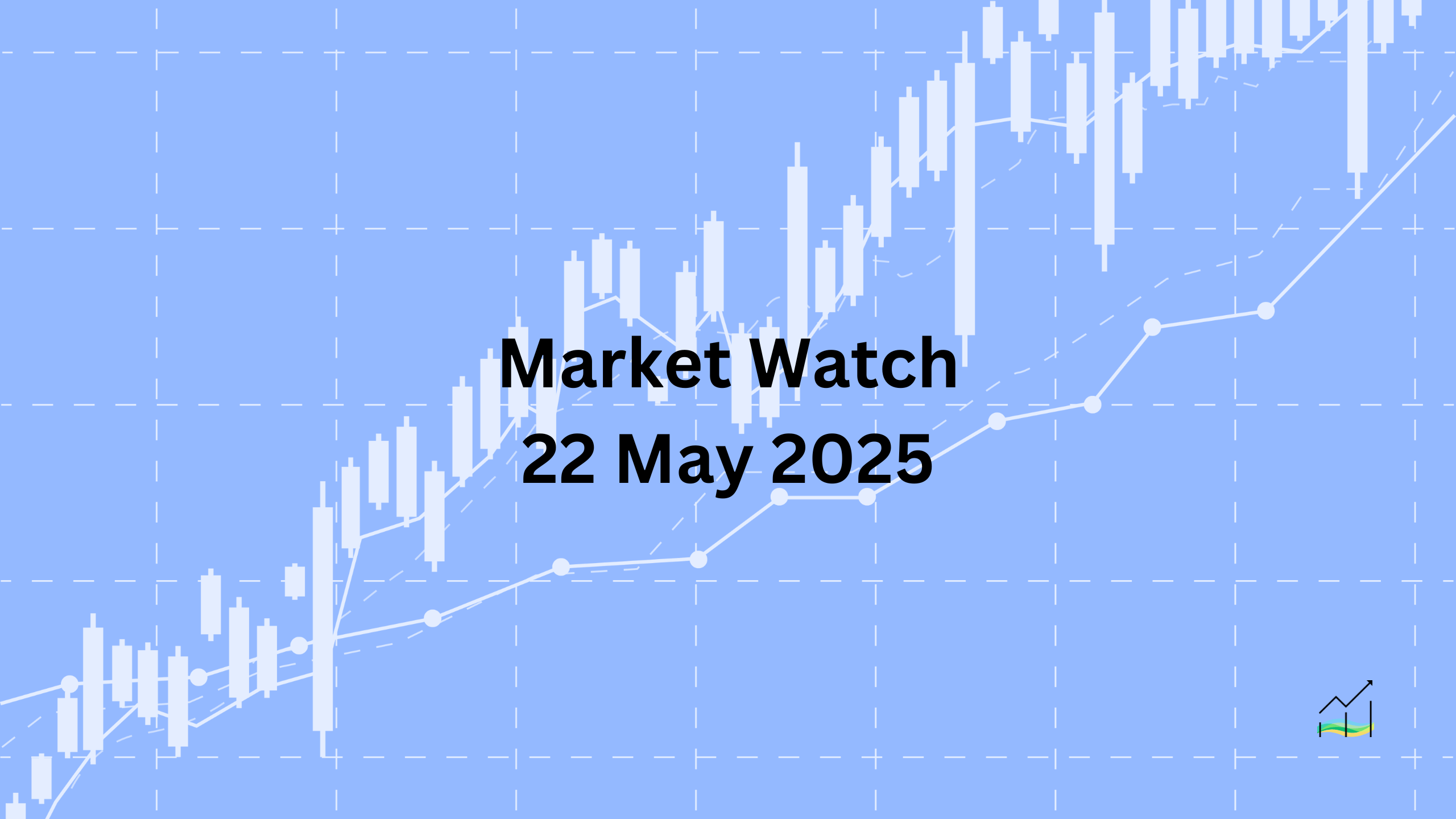22/05/2025 Market Watch

Weak PMIs, FX Concerns & Volatile Commodities
Key Takeaways:
- Flash May PMI data from Europe and Asia Pacific disappointed, helping stabilize the US dollar.
- Concerns over FX discussions between the US and Japan continue to pressure the yen and other Asian currencies.
- Global equities remain under pressure following US losses; European stocks and Asian markets broadly declined.
- Gold and oil prices reversed sharply after recent surges, driven by geopolitical tensions and supply concerns.
Financial markets faced renewed pressure at the start of the week as disappointing flash PMI data from both Europe and the Asia Pacific region weighed on sentiment. These figures, which signal a loss of momentum in global business activity, allowed the US dollar to stabilize following a sharp decline the previous day. Asian currencies, particularly the yen, have come under stress after reports suggested that exchange rate issues were raised in bilateral trade talks with the United States. The presence of substantial unhedged dollar exposures across several Asian economies has added to the vulnerability, intensifying recent currency market turbulence.
The US dollar extended gains against all G10 currencies except the yen, which was also affected by the renewed focus on foreign exchange policy. Notably, the dollar continued to weaken against the Taiwan dollar for the third session in a row and for the sixth time in the last seven trading days, highlighting pockets of resilience within the region.
Equity markets mirrored the growing unease. After sharp losses in the US, Asia Pacific indices followed suit with widespread declines. In Europe, the Stoxx 600 is down nearly 1%, on track for its first consecutive daily losses in two weeks. US futures showed modest stabilization, though broader risk sentiment remains fragile. Sovereign bond yields presented a mixed picture—Japanese bonds remain under pressure, European yields edged slightly higher, while US Treasury yields pulled back modestly after yesterday’s surge.
Commodities, too, reflected the market's volatility. Gold prices surged to a nine-day high near $3345 before retreating to session lows below $3305. Oil prices reversed steep gains triggered by geopolitical fears, notably speculation of Israeli military action against Iran. Confirmation that OPEC+ intends to continue increasing output added to the bearish pressure, sending July WTI crude down toward its 20-day moving average near $60.40.
United States of America
Overview
The US dollar is under pressure as the Dollar Index broke below 99.50, indicating a loss of recent upward momentum. The index is now consolidating in a narrow range between 99.45 and 99.85, with resistance expected near the 100.00 level. The broader trend points to a weakening technical outlook as key short-term averages begin to reverse.
Behind the currency’s performance lies a growing unease in the US labor market. Recent data shows a consistent slowdown in job creation, with April marking the third consecutive month where the three-month average of non-farm payroll gains fell below the six-month average. Year-to-date employment growth is nearly 20% lower compared to the same period last year. Signs of stress are also appearing in weekly jobless claims, with both initial and continuing claims rising to their highest levels in months.
Economic sentiment remains fragile. Concerns around reduced immigration, government job cuts, and sluggish tourism activity contribute to the broader slowdown. While Fed Chair Jerome Powell continues to highlight the divergence between weak survey data and more stable real-sector performance, today's preliminary May PMI is not expected to shift market expectations significantly. Housing data may offer some relief, with April existing home sales forecast to rebound from a steep drop in March.
Economic Drivers
- Slowing US labor market, with weaker job growth trends.
- Rising jobless claims indicating increasing financial stress.
- Cooling immigration and government layoffs contributing to employment drag.
- Weak tourism demand as a reflection of broader economic caution.
- Divergence between soft data (surveys) and hard data (real economic activity).
- Federal Reserve's cautious stance on interpreting mixed signals from the economy.
Data and Events
- 22 May 2025: Unemployment Claims.
- 22 May 2025: Flash Manufacturing & Services PMI.
- 22 May 2025: Existing Home Sales.
Price Action
- Dollar Index broke below key support at 99.50, now consolidating between 99.45 and 99.85.
- Resistance seen at 100.00.
- Five-day moving average is on track to cross below the 20-day moving average.
- Momentum indicators are starting to turn lower, reinforcing a bearish bias.
Key Points:
- Dollar under pressure as technical signals weaken and labor market concerns grow.
- Rising jobless claims and reduced job creation point to economic deceleration.
- Real-sector data remains stronger than sentiment surveys, limiting market reaction to PMIs.
- Focus turns to housing data for signs of resilience.
Australia
Overview
The Australian dollar has rebounded sharply after dipping on dovish central bank signals earlier in the month. It climbed to a five-day high near $0.6470, demonstrating resilience despite mixed market sentiment. While the currency is now showing a slightly softer tone, it remains within yesterday's range and has found support around the $0.6400 level. Consolidation remains the dominant theme this month, with limited directional conviction as markets await fresh catalysts.
Recent economic data has provided a neutral signal for the Australian economy. The manufacturing sector, which had strengthened throughout the first quarter, showed signs of stabilisation in April and May, holding at 51.7 in the latest flash reading. Meanwhile, the services sector continued to lose some steam, dipping to 50.5 in May after a 51.0 reading in April. The composite PMI, reflecting overall business activity, also edged lower to 50.6. While these figures suggest the economy is still expanding, the pace has clearly slowed compared to a year ago, when the composite index stood at 52.1.
Overall, Australia appears to be entering a phase of modest economic moderation. While conditions remain positive, the marginal declines in business activity hint at growing caution among firms, likely tied to uncertainties around global demand and domestic policy.
Economic Drivers
- Recovery in the Australian dollar following earlier central bank-driven weakness.
- PMI figures show a plateau in growth, with both manufacturing and services sectors stabilising.
- Services sector expansion is slowing but remains above contraction territory.
- Composite PMI shows mild softening in overall economic activity.
- Slower pace of growth compared to the same period last year signals cautious optimism.
Data and Events
- 22 May 2025: Flash Manufacturing & Services PMI.
Price Action
- Australian dollar reached five-day high near $0.6470.
- Currently trading within previous session’s range between $0.6415 and $0.6470.
- Support found near $0.6400, with last week’s low at $0.6355.
- Momentum indicators suggest ongoing consolidation without a clear directional bias.
- Trendline resistance sits near $0.6485.
Key Points:
- Australian dollar rebounds after earlier central bank pressure but remains rangebound.
- Business activity is stabilising, though momentum has cooled from earlier highs.
- PMI readings point to a slowing but still expanding economy.
- Technical outlook remains neutral as market consolidates.
Europe
Overview
The euro climbed above its 20-day moving average midweek, briefly pushing through to levels above $1.1360, but momentum faltered. Despite short-term technical improvements, the currency turned softer heading into late European trading, retreating toward $1.1290. This shift in sentiment follows disappointing preliminary PMI figures for May, which showed the eurozone economy struggling to maintain expansion.
The manufacturing sector remains in contraction territory, printing at 49.4 in May. Although this marked the fifth straight monthly improvement, the index has not crossed above the 50 threshold since June 2022. More concerning was the services PMI, which dropped sharply to 48.9 — its lowest level since November and the largest monthly decline so far this year. As a result, the composite PMI slipped to 49.5, indicating overall contraction in business activity across the region.
Germany’s performance mirrored the eurozone trend. Both manufacturing (48.8) and services (47.2) remained below 50, with the composite index falling to 48.6, the weakest of the year. The German IFO survey offered mixed signals: expectations continued to rise and reached a one-year high, but current assessments declined for the first time in three months. In France, both the manufacturing and services sectors stayed in contraction territory, although the slight uptick in the composite PMI to 48.0 tied with this year's previous high.
Despite the weakening data, markets remain convinced that the European Central Bank will proceed with a rate cut during its meeting early next month.
Economic Drivers
- Persistent weakness in eurozone manufacturing, despite five months of marginal improvement.
- Steep decline in services PMI, falling below 50 for the first time since November 2024.
- Composite PMI suggests overall contraction in economic activity.
- German PMIs remain below 50; composite at year-low of 48.6.
- German IFO expectations improved, but current conditions weakened.
- France’s composite PMI ticked higher but remained below 50.
- Market maintains confidence in an ECB rate cut next month.
Data and Events
- 22 May 2025: Eurozone Flash Manufacturing & Services PMI.
- 22 May 2025: German ifo Business Climate.
Price Action
- Euro rose above $1.1360 before reversing to session lows near $1.1290.
- Resistance noted near $1.1380, which is the 61.8% retracement of the April decline.
- Support seen between $1.1265 and $1.1280.
- Momentum indicators are turning higher.
- Five-day moving average is about to cross above the 20-day moving average.
Key Points:
- Eurozone PMI data signals contraction, especially in the services sector.
- Germany and France both remain below 50 across major indices.
- IFO survey shows improving expectations, but weaker present outlook.
- ECB is still expected to deliver a rate cut in early June.
- Euro failed to hold gains, retreating from recent highs.
Japan
Overview
The Japanese yen continued to strengthen against the US dollar, marking its third straight daily gain and its sixth in the past seven sessions. The dollar touched a two-week low near JPY142.80 before rebounding modestly. A brief spike occurred after US and Japanese officials denied discussing specific exchange rate levels, but the upward move was short-lived as markets sold the dollar once again. Currently, the pair appears to be stalling near JPY143.50, with technical momentum shifting in favour of the yen.
Economic data continues to suggest a fragile recovery. Japan’s preliminary May manufacturing PMI edged slightly higher to 49.0 but remained below the 50 threshold, marking an extended period of contraction since mid-2024. The services sector, previously a source of relative strength, also softened, falling to 50.8 from 52.4. Consequently, the composite PMI dipped below 50 for the first time since late last year, landing at 49.8. These figures indicate a modest deceleration in economic activity.
In the bond market, long-term Japanese Government Bond (JGB) yields have surged sharply, raising concerns about financial stability. The 40-year yield has climbed by over 110 basis points over the past seven weeks, while the 30-year has risen by more than 85 basis points. Insurance firms, which are more sensitive to the long end of the curve, have come under renewed pressure. The Topix insurance index has declined for four consecutive sessions and is down over 4% this week alone. Meanwhile, Japanese bank stocks have shown resilience, recovering nearly 40% since their April lows after a sharp plunge in March.
Economic Drivers
- Official comments suggest current exchange rates reflect fundamentals, dampening speculation over FX interventions.
- Manufacturing PMI remains below 50, signalling continued contraction.
- Services PMI softened notably, indicating weaker domestic activity.
- Composite PMI dipped below 50, reflecting overall economic slowdown.
- Rising long-term JGB yields are creating financial pressure, especially for insurance firms.
- Bank stocks have recovered strongly despite earlier losses.
Data and Events
- 22 May 2025: Japan Flash Manufacturing & Services PMI.
Price Action
- USD/JPY fell to a two-week low near JPY142.80 before bouncing to JPY143.50.
- Gains were capped despite initial reaction to comments from US and Japanese officials.
- Momentum indicators have turned lower.
- Five-day moving average is crossing below the 20-day moving average.
Key Points:
- Yen gains as markets sell the dollar despite official reassurances.
- Japan’s composite PMI drops below 50, pointing to economic deceleration.
- Long-end JGB yields continue to surge, pressuring insurance sector.
- Bank stocks outperform with a near 40% rebound from recent lows.
- Technical momentum favours further yen strength in the near term.
United Kingdom
Overview
The British pound surged to a new three-year high near $1.3470, underpinned by improving market sentiment and upward momentum. The recent move higher has been supported by the crossover of short-term moving averages and strengthening technical indicators. However, a more neutral tone has emerged in the latest session, suggesting that the rally may be pausing. A break below $1.3370 could signal the beginning of a near-term correction.
On the economic front, the latest preliminary PMI data painted a mixed picture. The manufacturing sector remains deep in contraction, with May’s reading slipping slightly to 45.1 from 45.4. The sector has not posted a reading above 50 since September 2023, highlighting ongoing weakness. In contrast, the services sector returned to expansion territory with a preliminary May reading of 50.2, after briefly falling below 50 in April. Despite the improvement in services, the composite PMI remained below 50 for a second consecutive month, signalling broader economic stagnation. At 49.4, the index remains well below the 53.0 recorded in May last year.
This suggests the UK economy continues to struggle with underlying softness, particularly in manufacturing, even as certain areas like services show tentative signs of stabilisation.
Economic Drivers
- UK manufacturing PMI continues to contract, extending a trend since September 2023.
- Services sector returned to marginal expansion after briefly dipping below 50.
- Composite PMI remains below 50 for a second month, indicating overall economic stagnation.
- Broader weakness across the UK economy, despite some resilience in services.
Data and Events
- 22 May 2025: Flash Manufacturing & Services PMI.
Price Action
- Sterling touched a new three-year high near $1.3470.
- Five-day moving average crossed above the 20-day moving average earlier this week.
- Momentum indicators are trending higher but not yet overbought.
- Current session shows consolidation; key support seen at $1.3370.
Key Points:
- Pound hit a three-year high before entering a consolidation phase.
- Manufacturing remains weak while services show modest recovery.
- Composite PMI signals continued economic softness in the UK.
- Technical outlook remains bullish but at risk of a short-term correction.
© 2025 SKONE Enterprise (003319453-V). All rights reserved.
The content on this site is for informational purposes only and does not constitute financial advice.


